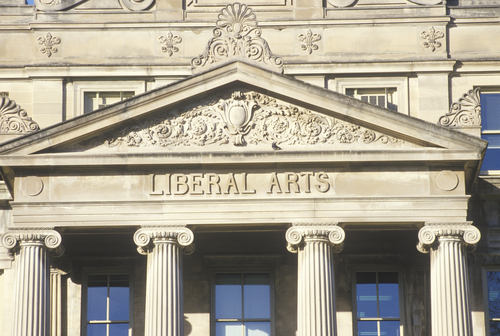How Students Are Taught to Think Critically at Liberal Arts

When you're comparing colleges as a prospective student, consider what kind of schoolhouse is right for yous and what kind of education yous desire. Liberal arts colleges provide students with a broad pedagogy that combines numerous subjects of written report in the arts, natural and social sciences, and humanities for the purpose of learning how to think and communicate. Rather than preparing students for a unmarried career path, a liberal arts education equips students with the skills and cognition they need to be better learners, thinkers, and global citizens.
A Liberal Arts Curriculum
At a liberal arts college, you volition study a variety of subjects in the arts, humanities, and natural and social sciences. Students in liberal arts colleges may report several of the artistic arts. Courses in fine art, music, theatre, and creative writing are common. The humanities refer to subjects that study the human status and culture. In liberal arts programs, students frequently take humanities courses such as history, classical or modern foreign languages, philosophy, English literature, and theology. Social sciences, too, concord an important place in a liberal arts curriculum. Expect to study subjects like sociology, geography, anthropology, political science, and economics during your liberal arts education.
You might non exist able to tell by the name, but mathematics and science are crucial subjects of written report in a well-rounded liberal arts education. Courses like biology, physics, and chemistry are mutual in a liberal arts curriculum. Students typically have to accept a minimum of 1 college-level math form during their academic careers, with options ranging from statistics to algebra, trigonometry, and calculus.
The Jobs of Tomorrow
Most people accept a moment when they're young where they think, When I grow up, I'thou going to be a ____ and they fill in the bare with whatever career appeals to them at that moment. While it's nice to dream about the jobs we might hold tomorrow, the truth is most people don't actually know what the jobs of tomorrow will be. According to Southwestern University, this argument isn't hyperbole. Around 65% of students today will be in jobs in the time to come that don't be today. Even more unsettling is the fact that 40% of the jobs that currently exist won't exist in the futurity. They'll go obsolete.
Information technology begs the question, and so, how are students expected to gear up for this eventuality? Won't this reality make college degrees useless? No, that isn't the case. The people who are best suited for these jobs are those who studied the liberal arts.
Here's why. A liberal arts education teaches students how to think and to solve issues. Retrieve about information technology this way. One plus one always equals two. Unfortunately, problems fill the world that don't fit into dandy mathematical equations. More than one correct respond to a problem frequently exists. Some problems likewise require more than one solution in order for them to be solved effectively. Those who know how to use their creative muscles usually solve those issues.
…Information technology's technology married with liberal arts, married with humanities, that yields usa the results that make our heart sing. – Steve Jobs
It isn't that Stem career fields don't have their identify in the world. They definitely do. Notwithstanding, every bit even many in the Stalk fields have begun to discover, the bug that crusade problems in the Stem world are human being issues. Technology past itself won't solve those problems. Someone with an understanding of both STEM and the humanities has a meliorate shot at it.
It stands to reason, and so, that the jobs of the future will be held past people who know how to solve bug, perchance even problems that the modern workplace hasn't experienced yet. The liberal arts students of today have put themselves in the position of being the workplace trouble-solvers of tomorrow. They become the people working in the jobs of tomorrow.
Education Beyond the Disciplines
A liberal arts pedagogy equals an education that spans the disciplines. Many universities require their students to complete a sure number of classes in subjects that aren't related to a student's major. Schools often telephone call these clusters of classes core or foundational classes. These include classes in literature, arts, sciences, mathematics and social sciences. These courses provide students with a foundational noesis of the earth and its history.
These classes innovate students to subjects they may not encounter otherwise. Sometimes, these courses even influence a student's decision when information technology comes time to pick a major. A class that introduces students to the study of art, biology, or field archaeology may become the stepping stone to a whole career down the road. Given that many students enter college with no item major in mind, it really is possible for a seemingly random class to alter a student'due south whole career outlook. Ofttimes that'southward how people encounter their dream careers: by accident.
Aside from this, these classes help students understand how i discipline affects another. For example, in a foundational geology course, students may learn that in 1815, a volcano erupted in Republic of indonesia. According to Forbes, the effects of the 1815 volcano were such that it changed the atmospheric condition around the earth, including in Europe in 1816. That twelvemonth also happened to exist the year that Mary Shelley wrote "Frankenstein." Shelley's volume was partly influenced past the dark and stormy weather condition that the volcanic eruption caused. In fact, people called 1816 "the year without summertime" because the volcanic ash caused terrible weather.
Growing crops was incommunicable in 1816. People starved. They moved across the European landscape in search of nutrient, much the way the animate being in "Frankenstein" did. His appearance is said to be inspired past those climate refugees. Out of this devastation came one of the most dearest pieces of literature the world has ever known.
A liberal arts instruction exposes students to facts like this. It allows them to run into how seemingly unrelated events affect the world. This exposure gives rise to newer, broader ways of thinking. As "Frankenstein" proves, a situation that occurs halfway around the world from someone can have profound effects on localities half a globe away. The study of liberal arts teaches students about these events. Information technology also forces them to examine how they might deal with such an upshot, which broadens their creative thinking and trouble-solving skills.

A Component of STEAM
Many people who work in engineering science accept begun to understand that not everyone wants a career in a Stalk field (scientific discipline, technology, applied science, or math). However, that doesn't hateful that liberal arts majors and STEM majors need to be at cross-purposes with each other. On the contrary, each subject field has something to offer its counterpart.
The addition of the "A" and the "R" to STEM brings both the arts and reading and writing into the STEM curriculum. Truth be told, many students in the liberal arts use technology every day to do their work. On the flip side, those who comprehend STEM fields run into the shortfall that merely concentrating on Stem causes.
Very often, Stalk problems aren't due to technical issues per se. Instead, they arise because humans run technology. They encounter ethical issues. They realize that the digital dissever keeps some people from accessing applied science in a fashion that is meaningful. Stalk training alone doesn't solve these issues. Knowledge of the man condition and ethics frequently does. For example, a educatee who studied philosophy may go on to take a career in health administration or law, co-ordinate to the University of Maryland because these career fields require people to have an agreement of ethics and the humanities.
That beingness said, a person who has studied philosophy, i of the many liberal arts majors bachelor to students, is in a unique position to move into a tech career. This is due in function to the fact that this particular liberal arts caste requires students to study logic. It also taps into how the brain works and how people call back. That beingness said, mod computer scientists often effort to replicate how the homo brain thinks, something that liberal arts majors must call up virtually a lot. This puts many liberal arts majors (and not merely philosophy majors) in the running for some very cool, very lucrative careers.
Career Options for Liberal Arts Majors
Many people mistakenly believe that a liberal arts education is the piece of cake way to a degree. Nothing could be further from the truth. A liberal arts educational activity requires students to adhere to rigorous standards of inquiry, to develop problem-solving skills, and to expend a large dose of commitment in lodge to accomplish their educational goals.
A liberal education also prepares students for a number of careers that may not seem to be related on the surface. Nevertheless, due to the wide nature of these types of degrees and due to the transferable skills they teach students, a liberal arts degree can actually interpret into very lucrative job options.
 Some liberal arts students parlay their power to write, a skill they honed during their college days, to become writers. Many plough to careers in journalism or public relations. Others combine their dear of technical subjects and writing to go technical writers. Depending on the job they do and the number of years of experience they bring to the table, these former liberal arts majors earn betwixt $61,000 and $70,000 a year.
Some liberal arts students parlay their power to write, a skill they honed during their college days, to become writers. Many plough to careers in journalism or public relations. Others combine their dear of technical subjects and writing to go technical writers. Depending on the job they do and the number of years of experience they bring to the table, these former liberal arts majors earn betwixt $61,000 and $70,000 a year.
Others turn their dearest of promotion into a lucrative career in the field of marketing. Possible jobs include marketing director, SEO writer, advertising designer, or art director. These professionals earn between $100,000 and $131,000 per year, according to Maryville University.
The field of education also proves to be a popular option amid liberal arts graduates. Typically, these graduates choose a major, like fine art or biology, and then they tack on classes in educational activity. If these students earn a bachelor's caste, they become elementary or high school teachers. If they earn avant-garde degrees, similar a main's or doctorate, they qualify for educational activity positions at the university level.
Given how much liberal arts students must read and write during the course of their studies, it'southward no wonder that many of them become first-class researchers in the process. This skill qualifies them to go research analysts. Big companies rent researchers when they need to make decisions about rolling out new products services or if they want to motility into new markets. Research analysts make almost $80,000 a twelvemonth on average.
 Translators and interpreters normally come up to the ranks of one-time liberal arts majors. People who major in world languages put themselves in a position to translate documents, books, Goggle box shows, and movies or to translate proceedings at conferences, business organization meetings, and in court. U.S. News & World Report name translation and interpretation as the #ane jobs on the news site's Best Creative and Media Jobs list.
Translators and interpreters normally come up to the ranks of one-time liberal arts majors. People who major in world languages put themselves in a position to translate documents, books, Goggle box shows, and movies or to translate proceedings at conferences, business organization meetings, and in court. U.S. News & World Report name translation and interpretation as the #ane jobs on the news site's Best Creative and Media Jobs list.
People who speak Spanish, Chinese, German, Portuguese, and Russian take especially lucrative futures alee of them. Demand for those who have these skills is expected to increment by almost twenty% through the year 2028. On average, translators and interpreters brand about $50,000 per year, though the best paid among them make $67,000 a year and above.
An Instruction for the Sake of Learning
At a liberal arts college, the main goal is instruction itself, more so than job training, according to The Hechinger Report. Instead of focusing mainly on learning specific technical skills that can become outdated very rapidly thanks to changes in applied science and the economy, a liberal arts education teaches students to remember, acquire, and communicate. That doesn't hateful a liberal arts education is useless for getting a job. A liberal arts curriculum includes plenty of reading, critical thinking, and work involving written and spoken communication. This makes for neat preparation for graduate school in subjects such as business concern, applied science, police force, and fifty-fifty medicine.
The didactics path likewise allows students a hazard to cultivate versatile skills that employers in all fields prize, like teamwork, communication, and analytical skills, CBS News reported. Liberal arts students get good at thinking critically, seeing the big picture, working with a squad, and communicating well. Between these skills and their solid educational background in many subjects, liberal arts students have a stiff foundation that allows them to fit into a wide multifariousness of careers.
A liberal arts didactics is a great choice for students who beloved to learn and want to develop abilities that make them better students, more insightful employees, and more enlightened citizens.
Related Resources:
twenty Affordable Chief's in Journalism Online Programs
Elevation 30 Nigh Affordable Master'due south in Reading Online Programs
Tiptop 10 Highest Paying Jobs For Liberal Arts Majors
hatfielddouse1959.blogspot.com
Source: https://www.bestcollegesonline.org/faq/what-does-a-liberal-arts-education-teach-you/
0 Response to "How Students Are Taught to Think Critically at Liberal Arts"
Post a Comment